More HD Music Streaming
Amazon Music HD Service Launches!
Perhaps you’ve seen or read one of the numerous articles announcing the new Amazon HD Music streaming service. The headline on the BBC News website reads “Amazon launches HD music streaming” and follows that with “Amazon Music has become the first of the ‘big three’ streaming services to offer music in CD-quality audio.” The article by Mark Savage, a BBC music reporter, reports that Amazon will be using the FLAC format to stream “CD quality” and premium content at what they’re calling “Ultra HD”. I find it somewhat ironic that Amazon has opted for the letters “HD” as oppsed to “hi-res music” because consumers already know what HD means as it applies to television. I used the same reasoning during discussions of “hi-res” audio and music at meetings of the CEA’s high end audio board years ago. My proposal was rejected.
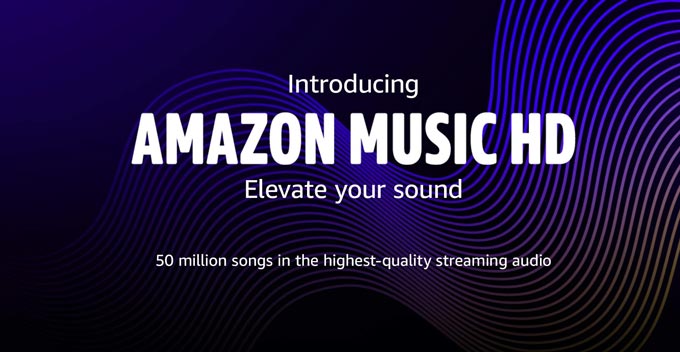
It does make sense to use HD as opposed to “hi-res” but hasn’t that ship already left the station? Is it really time to try and reorient everyone’s thinking about standard-res, hi-res, and HD with regards to audio? The amount of confusion among even knowledgeable audiophiles about what is and what isn’t actually “hi-res” is bad enough (just check out Neil Young’s new book!). But now Amazon is not only changing the name and branding of high-fidelity streaming music but they’ve also decreed that CD-quality should now be referred to as HD! And because Amazon is Amazon, they can pretty much do anything they want in the music streaming space — and just about everywhere else. At least they’ve opted out of the MQA nonsense that keeps spreading like a cancer on an increasing number of distribution channels. The main sales person at MQA came by my table at the recent RMAF and told me that MQA is now in discussions with NHK and the BBC about using MQA on their broadcasts. What about those of us who don’t want to pollute our audio with their lossy processing? Another case of one way — my way. Sad but true. Avoid anything MQA and perhaps we can stop it.
Same Graphic – Different Labels
After yesterday’s post, I heard from a number of readers pointing me to the Qobuz website and its discussion of audio quality. It’s curious that they employ essentially the same graphic that Sony has used in the past and that now also shows up on the Amazon Music HD page — a diagram that means absolutely nothing and is wrong on so many levels. Here’s the original from Sony’s site.
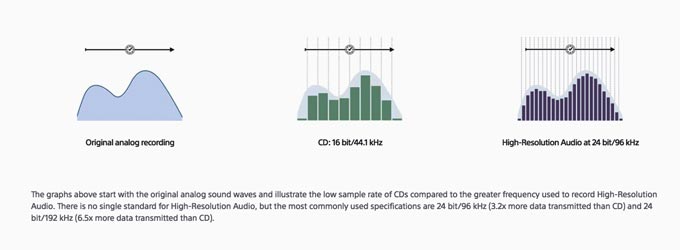
The graphic attempts to illustrate that resolution increases — you get closer to the original analog smooth curve — as you narrow the vertical bars and increase their number. There is some validity to the underlying this concept in terms of sample rate and word length but these illustrations do not capture it. And yet, this basic graphic shows up on Qobuz and the new Amazon Music HD site. Never mind that the Hi-Res Audio logo doesn’t apply to content. Take a look:
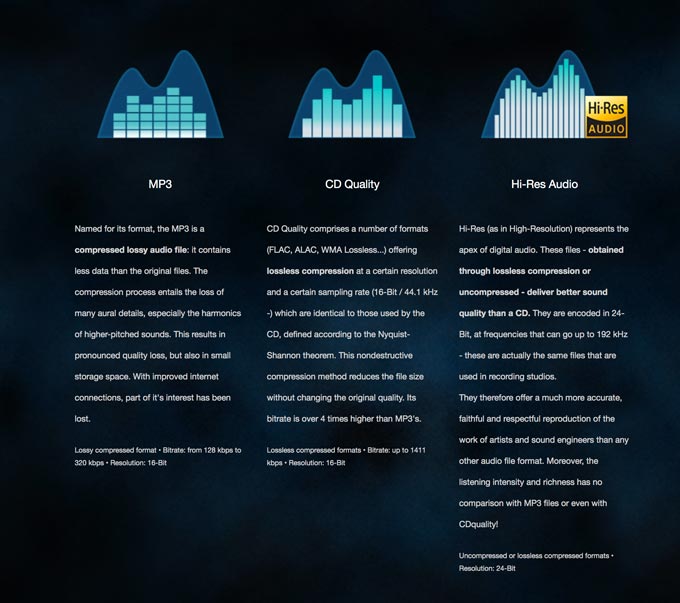
And below is the latest iteration of the same graphic as presented by Amazon:
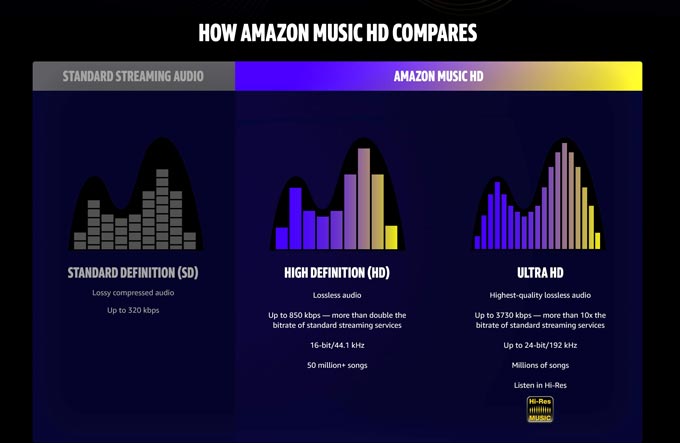
By merely relabeling the center graphic — the one associated with CD Quality — Amazon has changed 20 years of “progress” towards establishing a meaningful definition of hi-res audio or hi-res music. What was once standard-res — the venerable CD — is now HD and what used be hi-res music is “Ultra HD”. At least they’re using the right logo. But how did the “hi-res music” logo get moved over to the “Ultra HD” column? If it’s this confusing for those of us who follow this stuff, can you imagine how well the general music loving public is going to react to the new age of “hi-res” music — excuse me “HD Music”? And remember I got kicked out of the high-end audio board at the CEA because I lobbied hard for a single universal definition. Now Amazon launches a new service that muddies the water even more.
Creating a Buz – Streaming Hi Res Music with Qobuz
Finally, because I was looking around on the Qobuz site yesterday I noticed a link to the Qobuz seminar presented by their evangelist David Solomon at the recent RMAF on YouTube. I watched the entire 58 minutes “seminar/commercial” and transcribed a bunch of the things he said. More in a moment.
But first let me point out that when I inquired about presenting a seminar at the RMAF event, I received a polite email warning me that any potential seminar would have to rigorously avoid being a commercial for my company, my book, or recordings. Here’s a quote from the email:
“We would be interested in having you conduct a seminar, but … this is a little delicate, but we want to be sure you understand that your seminar cannot be an advertisement for your book. To be honest, this is more of a recommendation for people who offer seminars about specific products, and then push the ones they make or sell, but I have to say it to everyone! We had several complaints about that resulting from two different seminars in the past (not yours!). Our attendees love the information, but get resentful when they feel like they are trapped in a commercial. So, you should absolutely say you are the author of “Music and Audio: A User Guide to Better Sound,” and that it can be purchased at your booth, but only a couple of times. Then, we appreciate an unbiased sharing of information. Does that sound do-able? I really hope so, because your information is terrifically valuable to so many people!”
Apparently, David Solomon didn’t get the same email. His entire hour long presentation was a commercial for Qobuz, which he falsely claimed was the “first true high-resolution streaming service ever.” You can watch the video for yourself by clicking here, but be sure to set the speed at 2X to save time. He said some other things that missed the mark as well. He said that Qobuz has “loads and loads of high-resolution tracks – about 40 million.” Although, the slide that he displayed at the very moment he bragged about the number of “high-resolution” tracks they have contracted that claim.
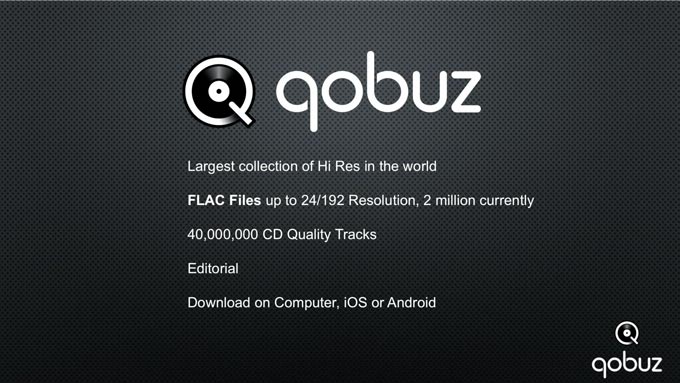
He went on to say that they are ingesting about 45,000 tracks a day. My guess is — like the other streaming companies — they are merely pushing a CD into a drive and ripping the audio, which decidedly not hi-res unless you’re Amazon I guess.
At around 29:00 minutes into his commercial – er seminar, he defines high-resolution. “Here’s what high-resolution is. It’s not big stuff. It’s little stuff. It’s tiny stuff. It’s millions and millions of tiny details that are added to the music — or not taken away from the music — that make up high-resolution. That’s what high-resolution is. It’s not the big stuff. It’s not the bass notes. It’s not the crescendos. It’s what you’re hearing right now. It’s the decay of a room.” This sound more like a review of an expensive power cord or $1000 USB cable than a universal definition. I find myself longing for the clarity of the original definition issued by the label, NARAS, and the DEG many years ago. They simply stated that high-resolution audio is fidelity is higher than CD Redbook.
My favorite moment of his presentation came about half way through. He was asked by a member of the audience (which numbered about 10 from I could see in the video) , “Does anyone care about hi-res?” David replied, “No, they don’t. Man, that is a great question. They don’t.” Huh?
The players — both large and small — in high quality audio streaming are screwing up this once in a lifetime opportunity. Amazon feels it can simply redefine all of the standards, Tidal clings to the MQA farce, and Qobuz blindly accepts every file from every source and attaches the “hi-res audio” logo to them. And in the end, does anyone care about hi-res? David’s answer was the most accurate thing he said. No, they don’t.
A New Book on High-Res Streaming
The more I begin to research the areas of high-resolution streaming, downloads, and personal audio, the more confused I get. The companies, reviewers, and websites pitching this stuff present a lot of conflicting and bad information in service to their bottom line. As much as I do not want to spend the next year of my life researching, writing, and illustrating another book, I’ve made the decision — a book on this topic is sorely needed. I will be raising the initial funds using Kickstarter once again. Stay tuned.
If you want to learn more about this new book or get on the mailing list, please visit: http://www.sdpaguide.com/. And if you have any specific areas that you would like me to address in the new book, please let me know. You can always write me at mwaldrep@aixmediagroup.com or enter your question in the online form on the website.
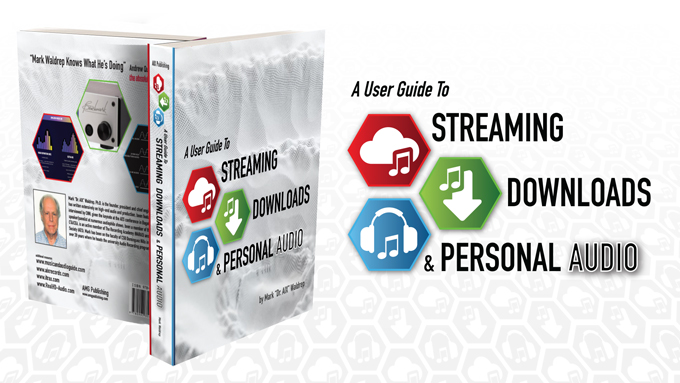
As always, thanks for your continued support. The world of high end audio deserves accurate information and I hope this blog remains a trusted source.

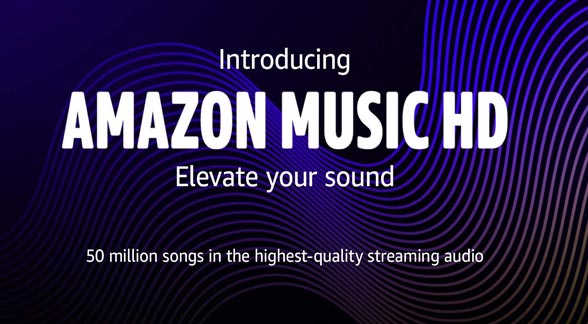
Siempre es un placer escucharle. Es como si entrara un aire fresco por la ventana. Lástima que las grandes marcas quieran confundir al personal. Somos unos pocos los que estamos en lucha contra los engaños. Cómo “Quijote enfrente de los molinos de viento”.
Animo amigo Mark. Que disfrute usted de la familia y su perrito. Mucha salud.
Saludos desde España.
Hi Mark
I agree at least they use the term Hi Definition but to be promoting CD ‘quality’ as hi definition is a bloody joke!
The naming could have been worse. Imagine if they’d followed the video tradition to the letter. Then CD quality would be called “HD ready,” 96 kHz would be “full HD,” and 192 kHz “Ultra HD.” 24-bit “high dynamic range” (HDR) would be available with UHD, but only if your DAC supported whichever of several incompatible encodings each track happened to use.
Finally someone who has the guts to call CD-Resolution “HD”. The “SD” was not doing justice to this great format. Noone can hear a difference between a CD and hi-res, so essentially the CD is indeed “HD”. Amazon has my blessing!
So standards and meaningful definitions mean nothing? CD is a great format and can deliver incredible sound but it is not HD and never will be. Amazon is deliberately confusing consumers. Shame on them.
I am trying Amazon HD music right now on a Windows PC using their app (at least they told me I needed to use the app to get “HD” when I was using a browser to stream)
My speakers are $100 CR3 Mackie Studio Monitors.
Listening to Johnny Marr’s “The Messenger” which is labeled “Ultra HD Audio” — status is reported as “Currently playing at: 24 bit / 44.1 kHz”
My conclusion is it sounds like the treble is boosted a bit with an equalizer. Essentially the same as my Google Play Music subscription quality. So it could be sounding a bit better? Really hard to tell.
I sort of like the Amazon windows client though. I am mostly on Linux and Chromebooks now (and Android phone). I have the Google music family plan. The Amazon HD family plan is $3 more per month than Google. It might be worth switching to Amazon!
Still this whole “Ultra HD” labeling is crap. We need a better system to explain the studio-master-stream quality settings!!! Keep up the good fight Mark!
Hey Mark,
I’ve been following you for awhile and wanted to get a taste of digital music recorded at 24/96, so I went to your AIX record website to take advantage of your 35% off sale to buy the Guitar Noir album. But I discovered that I couldn’t purchase just a digital FLAC download; I had to purchase the DVD-A version then add on a digital download. I may be wrong, but that seems to be different from the prior practice under your prior AIX website. Is there any way to purchase just a digital download? I don’t have any equipment that can take advantage of a DVD-A.
Charles C.
Btw, I’m leaving a message here because the “Contact” page on the AIX website was blank and didn’t provide an opportunity to send you this question.
Charles, the iTrax website had to be moved and is not yet been rebuilt. I will happily sell you a digital download in any format of any album I have…just send me an email at mwaldrep (at) aixmediagroup.com
Back in the early 1990s when I first became aware of so called high end audio I thought it was insane for people to spend $1500 to $2000 for a pair of 8″ two way small speakers. Today speakers like Joseph sell; 5.5″ two way even smaller speakers for $7000. It seems as time goes on you pay more and more to get less and less in high end audio. In that spirit the world of “high end” recordings has kept up with the trend. Now you pay something for a recordings with a lot of extra zeroes. Paying something for nothing is about as high a profit as you can make. What’s more, even if they weren’t zeroes you couldn’t hear them anyway. At least not according to our science. It’s absolutely fantastic. It’s even better than charging for breathing air. As for RBCD here’s a demo that will show what it can do that you can hear.
https://www.youtube.com/watch?v=XFxiLeQmb5k